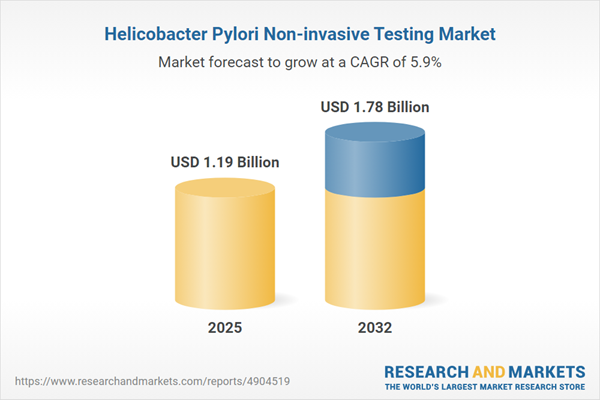Speak directly to the analyst to clarify any post sales queries you may have.
Senior leaders in healthcare diagnostics face a period of unprecedented change as procurement strategies, regulatory frameworks, and emerging technologies rapidly evolve. The Helicobacter pylori non-invasive diagnostic testing market stands as a key opportunity for those intent on driving patient-centered care and improving operational responsiveness in today’s healthcare environment.
Market Snapshot: Helicobacter pylori Non-Invasive Diagnostic Testing Market
In 2024, the global Helicobacter pylori non-invasive diagnostic testing market is valued at USD 1.12 billion, indicating a dynamic sector shaped by increasing demand for risk-based, patient-centric testing across hospitals and clinics. This market shift is propelled by a universal focus on early detection and robust monitoring, pushing providers toward investment in technology-driven, non-invasive solutions. Operational efficiency is being achieved through lab automation, advanced analytics, and flexible diagnostic platforms, enabling clearer decision-making and accelerated patient care. As competition intensifies, especially in emerging regions, healthcare organizations must navigate complex regulatory environments and adjust approaches to variable rates of technology adoption and compliance requirements. Grasping these nuances is essential for maintaining a leadership position in a transforming industry.
Scope & Segmentation: Structure of the Helicobacter pylori Diagnostic Testing Market
- Test Types: Serology-based diagnostics support immunoglobulin detection, while stool antigen assays use monoclonal or polyclonal antibodies, blending high precision with ease of use. Urea breath tests enable practical screening and management options for various care settings.
- Technology Platforms: ELISA and rapid immunoassays provide strong reliability for laboratory settings. Laboratories aiming for efficiency are adopting infrared spectroscopy, LC-MS, and GC-MS to increase throughput and clinical confidence. The uptake of automation modernizes both centralized and distributed workflows.
- End Users: Primary care providers require immediate, actionable test outcomes. Specialty clinics depend on tailored diagnostic pathways. Diagnostic laboratories handle high-volume processing, and tertiary hospitals manage complex diagnostic requirements. Customization of workflows and procurement strategies ensures maximum value for every segment.
- Distribution Channels: Traditional offline suppliers continue to play a significant role, with digital procurement solutions increasing access to inventory management and product delivery. This dual approach enhances supply chain flexibility for hospitals and clinics.
- Regional Coverage: The market extends across the Americas, Europe, Middle East, Africa, and Asia-Pacific. Local infrastructure development, procurement strategies, and regulatory practices influence rates of adoption, with Asia-Pacific seeing a notable impact from innovative health models and expanding infrastructure.
- Companies Analyzed: Major industry participants include F. Hoffmann-La Roche AG, Abbott Laboratories, bioMérieux SA, Danaher Corporation, Thermo Fisher Scientific Inc., Siemens Healthineers AG, QIAGEN N.V., DiaSorin S.p.A., Meridian Bioscience, Inc., and SD BIOSENSOR Co., Ltd., all of which prioritize technology upgrades, regional strategy development, and compliance-focused growth.
Key Takeaways for Senior Decision-Makers
- The expansion of non-invasive testing options enables organizations to meet stringent quality standards while prioritizing patient-first service delivery.
- AI and automation adoption across laboratory and near-patient settings enhance diagnostic precision and allow faster clinical decisions.
- Organizations that actively adapt to changes in reimbursement and regulatory requirements reinforce their operational resilience and ensure sustained compliance in shifting environments.
- Establishing a diverse supplier base mitigates risks from service disruptions and stabilizes procurement, particularly during periods of policy change or market volatility.
- Scaling strategies tailored for regional differences yield greater success where healthcare maturity and procurement processes vary globally.
Tariff Impact: Navigating US Diagnostic Equipment and Reagent Tariffs
The rise in US tariffs affecting diagnostic reagents and equipment is driving stakeholders to diversify sourcing, invest in regional manufacturing capacity, and strengthen supplier relationships. These actions help maintain continuity of diagnostic services in the face of continued policy changes and trade uncertainties.
Methodology & Data Sources
This market assessment draws on in-depth executive interviews, structured survey responses, regular monitoring of regulatory policies, and a comprehensive review of peer-reviewed research. Additional data from patent analysis, annual filings, proprietary intelligence, and benchmarking support a reliable evaluation of all market segments and suppliers.
Why This Report Matters
- Enables decision-makers to anticipate developments in non-invasive diagnostic technologies, shifts in reimbursement practices, and global regulatory changes affecting Helicobacter pylori testing.
- Provides actionable market segmentation and practical industry benchmarks to inform technology investment priorities and guide expansion into target regions.
- Highlights collaborative approaches that sustain operational performance through regulatory, supplier, or industry shifts.
Conclusion
This report equips executives with clear, actionable insight to drive operational efficiency and make compliance-centered strategic decisions in a rapidly transforming diagnostic testing market.
Additional Product Information:
- Purchase of this report includes 1 year online access with quarterly updates.
- This report can be updated on request. Please contact our Customer Experience team using the Ask a Question widget on our website.
Table of Contents
3. Executive Summary
4. Market Overview
7. Cumulative Impact of Artificial Intelligence 2025
Companies Mentioned
The companies profiled in this Helicobacter Pylori Non-invasive Testing market report include:- F. Hoffmann-La Roche AG
- Abbott Laboratories
- bioMérieux SA
- Danaher Corporation
- Thermo Fisher Scientific Inc.
- Siemens Healthineers AG
- QIAGEN N.V.
- DiaSorin S.p.A.
- Meridian Bioscience, Inc.
- SD BIOSENSOR Co., Ltd.
Table Information
| Report Attribute | Details |
|---|---|
| No. of Pages | 192 |
| Published | November 2025 |
| Forecast Period | 2025 - 2032 |
| Estimated Market Value ( USD | $ 1.19 Billion |
| Forecasted Market Value ( USD | $ 1.78 Billion |
| Compound Annual Growth Rate | 5.8% |
| Regions Covered | Global |
| No. of Companies Mentioned | 11 |









